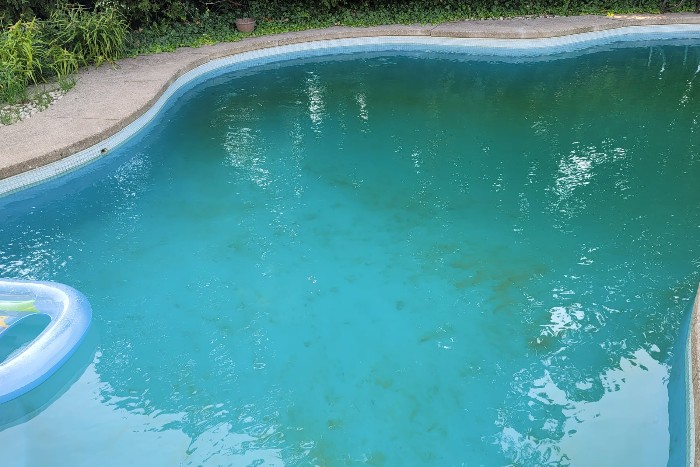Yellow algae, aka mustard algae, is derived from green algae and is tough to get rid of. However, with a little elbow grease and some algaecide, removing it and preventing it from returning is possible. Let’s look at the best and quickest way to get rid of yellow algae from your pool.

What You Need To Get Rid Of Yellow Algae In Your Pool
You will need some manual equipment and algaecide to get rid of mustard algae (aka yellow algae) from your pool. It’s best to treat it right away to prevent staining and to prevent it from coming back.
- Pool brush with telescoping pole
- Manual pool vacuum
- Water testing kit
- Shock treatment
- Algaecide
- Flocculant (optional)
| Image | Product | Features | Link |
|---|---|---|---|
 |
| 9.7 | Check Price |
 |
| 9.5 | Check Price |
 | U.S. Pool Supply 14" Manual Vacuum
| 9.1 | Check Price |
 |
| 8.8 | Check Price |
 |
| 8.6 | Check Price |
 |
| 8.2 | Check Price |
 |
| 8 | Check Price |
Article Contents
How To Get Rid Of Yellow Algae In Your Pool (In 10 Steps)
Since yellow algae or mustard algae is so hard to kill, follow these steps in order for maximum results. Making sure your pH is neutral (7.4-7.6) is key because yellow algae are more likely to bloom if the pH and alkalinity levels are off. If you have a severe yellow algae issue, you may have to repeat this process if the problem persists after 48 hours.
Step 1: Test your water
Testing the water will show if the chemicals are not balanced. If the pH is not neutral, it must be lowered or raised accordingly. After adding muriatic acid (to decrease pH) or pH increaser (to increase pH), wait two hours then test the pH again. And when the pH is correct, you can begin treating the yellow algae.
Important: The pH must be between 7.4-7.6 ppm before treatment of yellow algae.
Step 2: Clean Pool Filter
Clean the pool filter while you’re waiting for the pH to neutralize. This removes mustard algae build-up so it won’t run back into the pool. If you have a DE or sand filter, backwash and rinse the system.
Step 3: Brush the Walls & Floor

Brushing your pool’s walls, floor, and steps is another critical step before treatment. This loosens the yellow algae, which makes it easier to vacuum. Also, the shock cannot penetrate the algae unless the top layer of the algae is removed first.
Step 4: Shock The Pool
If your algaecide does not come with a clarifier (shock), add 1 gallon of liquid shock or two bags of granular shock per 10,000 gallons of water. Walk around the perimeter of the pool while adding the shock to ensure that the shock is distributed evenly.
Step 5: Add Algaecide
Read the instructions carefully and ensure you have enough algaecide to treat the gallon size of your pool and to see if it needs to be mixed with water before adding it. Then add it as per the instructions.
Step 6: Run Filtration System Until Yellow Algae Is Gone
Running the filter will eliminate any loose algae and keep the water circulating, preventing algae from blooming. I recommend brushing the walls again during this phase to expedite removal.
Step 7: Vacuum
Vacuum the pool thoroughly. Make sure to overlap your vacuum strokes and completely. Vacuum the walls, floor, and steps. If you are using flocculant, make sure you have brushed the walls and floor thoroughly to loosen any dead algae before you add the flocculant.
Tip for Vacuuming Dead Yellow Algae: Vacuum slowly so you don’t stir too much from the bottom.
Step 8: Clean or Replace Your Filter

Cleaning the filter removes the remaining yellow algae. I always recommend replacing the filter because the minute pieces of algae get trapped in the pleats and microfibers, and can always find their way back to your pool. This will help with recurring algae.
Backwash and rinse the system if you have a DE or sand filter.
Step 9: Test the Water
Test the water and balance the chemicals again. Retaining neutral pH (7.4 – 7.6) is critical in preventing future algae blooms. If possible, double-check your results by bringing a water sample to your local pool store to have an accurate chemical level reading.
Step 10: Shock After 48 Hours
This step is optional but practical and helps prevent any recurrence of yellow algae. I always re-shock the pool if the algae bloom is severe, but not necessarily if the outbreak is minor.
Products to Get Rid of Mustard Algae

There are several algaecides specifically designed for yellow algae.
There are three types of algaecides to choose from:
- Quaternary ammonium (quats for short)
- Polyquats and;
- Metals
Before you purchase an algaecide, make sure you know what type it is. If you have a green algae, follow our guide to get rid of green water fast.
Quats are cheaper, but adding too much will create foam in your pool. Polyquats are a little more expensive but will not foam or stain. Metals, primarily copper, do not foam but can cause stains over time, especially if you use too much.
I recommend a polyquat that not only treats the immediate problem but also is a preventative algaecide. These are three-month treatments that help prevent algae blooms from forming so long as the pool is regularly maintained.
Here are some suggested products to kill yellow algae:
| Yellow Algaecide Product Name |
| Kemtek 60 Percent |
| Yellow Out |
| Lo-Chlor |
| United Chemicals Yellow Treat |
How to Identify Mustard Algae
Yellow algae is a form of green algae resistant to chlorine.
It’s pretty easy to identify from other types of algae in color, texture, and location.
The main difference between yellow algae and other types is that it blooms in shady areas and clings to walls and other surfaces, while green algae float on the surface.

Yellow algae are greenish-yellow in color, are slimy, and look like sand in the bottom of the pool. It blooms, spreads fast, and clings to the pool walls, steps, and toys or other things in your pool. If the outbreak is severe, the water will be greenish-yellow in color.
If you’re not sure if you have sand or yellow algae, try to pick it up. If you can grip it, it’s sand; if it slips out of your hand, it’s yellow algae.
Once you have identified yellow algae, make sure to treat it instantly, or it will get worse and possibly stain your pool walls and floor.
Green & Yellow Algae Characteristics
| Yellow (Mustard) Algae | Green Algae |
| Color: Greenish yellow | Color: Different shades of green |
| Texture: Slimy | Texture: Slimy |
| Found: In shady areas and clings to walls, steps and toys | Found: Floats on the surface of the pool |
Tips to Prevent Yellow Algae
There are multiple ways to prevent yellow algae, or any algae for that matter, from blooming in your pool. The good news is that the preventative measures are basically the same maintenance routine that should be followed for all pools. An hour or two per week is all it takes to maintain a healthy pool free from algae blooms.
You should also be shocking your pool weekly or no more than bi-weekly to maintain the pool water’s chemistry. You should also shock after a large group of people has been swimming, as body oils and other cosmetics or lotions can lower the pH level.
- Test and balance water weekly
- Brush and vacuum weekly
- Clean the skimmer and pump baskets after you clean
- Clean the filter once a month and replace (the cartridge) every 12-18 months (some specialty filters last longer)
- If your pool has constant shady spots, add a long-lasting algaecide every three months, and when you shut the pool down for the winter
Best Way to Vacuum and Filter Yellow Algae

Yellow algae are stubborn and cling to anything in their way. Before doing anything, make sure to remove any algae blooms from any equipment you’re using. If you don’t, you will recontaminate the water while trying to remove the algae.
I prefer to use a manual vacuum with a debris chamber to remove algae. Using an independent debris chamber prevents the algae from entering the pool’s filtration system.
However, you can use your pool system to remove algae. But make sure you set the filter to “waste” so the mustard algae don’t enter the filter. Either way, you vacuum, you need to clean the filter before and after treatment.
When vacuuming the remaining algae, brush, brush, and brush all pool surfaces before vacuuming. Brushing loosens the algae and also scrubs the pores of the pool’s walls to get rid of any algae hanging out in the crevices. When vacuuming, use overlapping strokes and go slow to ensure you get all the remaining algae.
Should You Use Flocculant with Yellow Algae?
Flocculant is a pool chemical used to clear up algae or cloudy pools. It clumps the algae particles together, which causes them to sink to the bottom of the pool due to their weight. This is a great idea for the early stages of algae growth, but anything more than a mild green algae issue should get the full cleaning treatment.
You can also use a flocculant to assist when vacuuming dead algae. Some particles of dead algae are so small that they are hard to detect and vacuum or filter out. If these small particles enter the filter, they will likely recirculate back into the pool.
If you use flocculant before you vacuum, you will be more successful in removing the dead yellow algae.

